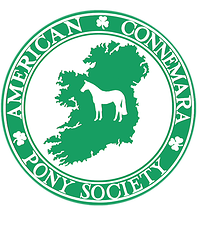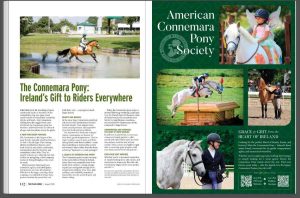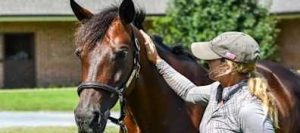The Connemara Breed Standard
Download the Connemara Brochure
Temperament |
Mannerly and manageable, kind, responsive, possessing good sense and basic intelligence. |
Type |
Rugged and sturdy; body compact, deep through the heart, with well-sprung rib cage and broad chest. |
Action |
Straight and true both front and rear with free movement in the shoulders. Connemaras should move underneath themselves and should be sure-footed, athletic, and clever, covering a lot of ground. |
Head |
Kind eye, head well shaped and balanced in proportion to the rest of the body; neck of good length and definition, meeting the shoulder smoothly. |
Shoulders |
Long, well laid back, and with good slope. |
Back |
Strong and muscular; some length of back is normal in Connemaras, especially in mares. |
Hindquarters |
Well rounded and deep with good length from the point of the hip through the haunch; should balance the shoulders. |
Bone |
Clean, hard, flat, proportionately substantial for height; forearms and gaskins long and muscular, cannons short and very dense. |
Joints |
Large and well defined. |
Feet |
Hard, strong. |
The Connemara Breed Definition
The Irish have contributed much to this country, and any owner will tell you the Connemara Pony is the greatest Irish contribution. For along with great athleticism and versatility, the Connemara has a special kindness, a huge heart, and an ability to bond with their human handlers that is unique to this breed.
Good-natured individuals may be found in most breeds, but for the Connemara Pony a gentle disposition is its most outstanding characteristic. Next would be the ability to adapt to any situation, excelling in all equestrian sports. Born out of poverty, the Connemara evolved from an unusual blend of natural selection and human need.
Rocky, barren mountainous terrain. Craggy, lunarscaped strands, pounded by the tide and storms of the Atlantic. Endless desolate moors and bogs. This is the area of Western Ireland known as Connemara, which lends its name to its indigenous pony breed.
The history is obscure, yet the Connemara Pony is considered Ireland’s only native breed. The ponies were brought to Connemara by the Ancient Celts, who were skilled horsemen. Mythology tells us that the tribes of western Ireland were mounted. Legend has it that when the Spanish Armada sank off the Connemara coast in the 16th Century, the horses swam to shore and bred with the native ponies running wild in the mountains. They learned to live on the tough vegetation and survive the hardships of their habitat, as a misplaced step could send a pony crashing to its death.
It was a desperate and arduous life for the farmers of the area. With large families to support, they could only afford one good pony – often captured off the mountain and tamed. This had to be a mare who could give him a foal each year, to sell for their subsistence through the long, dark winter. She would pull a plow, a cart, work from dawn to dusk at whatever task was needed under extremely harsh conditions.
Fitted with baskets called creels, they carried a heavy load. Tons of rock were moved by them, to claim the land. Seaweed used to fertilize the barren fields was dragged from the shore by the ponies. They carried turf cut from the bogs, used for cooking and heat. Strong, sturdy legs could maneuver through the muck, which might swallow a different type of horse. Never a day of rest, she also carted the family to Mass on Sunday. She had to have the hardiness, stamina and disposition needed, or she was replaced with a mare who could. In this manner, the good mares were kept in Connemara reproducing these qualities in their foals.
Stallions would travel the primitive roads between villages, covering many mares and many miles in one day. Local racing was popular and the Connemaras competed equally with the larger Irish Hunters and Thoroughbreds.
The Connemara Pony Breeders Society was formed in 1923 in Clifden by the local breeders for the purpose of conserving and developing the breed. Centuries of natural selection, some interference needed for human survival, followed by the past 72 years of selective breeding has given us the quality Connemara we have today.
The Connemara “Stands on short legs, covering a lot of ground”. The cannon bone is short, dense, flat and clean, measuring 7 to 9 inches below the knee. The body is deep and compact, well-balanced with depth, substance and good heart room. The Connemara has a good sloping shoulder, length of rein, and moves freely with little knee action in surprisingly large strides for its height. On this strong, sturdy body sets a handsome pony head, with a well defined jaw and good width between large kindly eyes. Easy keepers, they do not require a rich diet to stay healthy and fit.
The most common colors are gray and dun, but there are blacks, bays, browns, chestnuts, palominos, and an occasional roan. Black points are common, but paints are not acceptable.
The Connemara is the largest of the pony breeds, ranging in height from 13 to 15 hands, with 14 to 14.2 hands as the average. Full maturity is at five years of age, sometimes older, and they can live well into their 30’s.
The Connemara has a natural jumping ability, and its rectangular build lends it suitable for dressage. They often beat horses 16 hands and over with staying power, intelligence and heart. As a show jumper, working hunter, eventing, western pleasure, endurance, driving – Connemaras can do it all, and can be your best friend!
When one thinks of a pony breed children come to mind, yet the Connemara has always been a suitable mount for children AND adults. Here in the United States, the largest market for the Connemara is middle-aged women.
There are no large commercial breeding farms. Most keep only a few mares. After all, the Connemara breed was built on one good mare per farm. Foals are raised with much human contact.
Like the Irish people, the Connemara has been exported to all European countries, New Zealand, and Australia. Adapting to extremes of climate, they have made useful working partners with those who own them, and have competed with the best of the sport horse breeds.
The Connemara is the image of strength, kindness and trust. Their inner peace will calm you as they charm their way into your heart.
This description of the Connemara Pony written by Maureen Loughman Abel is based on her article in the October, 1995 issue of The Western Horse.



